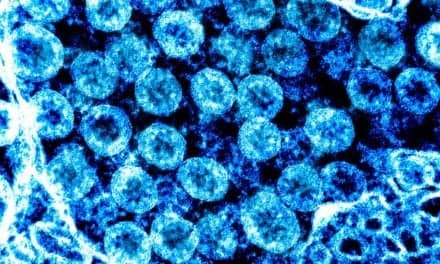Before covid-19 began to spread around the world, Jing Wang, PhD, and his team at the Swiss Federal Laboratories for Materials Science and Technology (EMPA) and ETH Zurich had been researching sensors that could detect airborne bacteria and viruses. But the global pandemic caused a shift in their research goals, and the team began developing a new sensor that can quickly and reliably detect the airborne presence of one specific virus—SARS-CoV-2.1
Wang and his team have developed a biosensor that combines measurements of optical and thermal effects to detect the virus safely and reliably.
The team’s new biosensor is not intended to replace established laboratory tests, although it could in theory be used as an alternative method for clinical diagnosis. Rather, its intended use is to measure the airborne concentration of the virus in real time, in places such as hospitals and train stations.
The sensor is based on tiny structures of gold, called nanoislands, on a glass substrate. Artificially produced DNA receptors that match specific RNA sequences of the SARS-CoV-2 virus are grafted onto the nanoislands. The receptors on the sensor are complementary to the virus’s unique RNA sequences, and can thus reliably detect the presence of the virus.
The technology the researchers use for detection is called localized surface plasmon resonance, which is an optical phenomenon that occurs in metallic nanostructures: When excited, they modulate the incident light in a specific wavelength range and create a plasmonic near-field around the nanostructure. When molecules bind to the surface, the local refractive index within the excited plasmonic near-field changes. An optical sensor located on the back of the substrate can be used to measure this change and thus determine whether the sample contains the RNA strands in question.
Adding heat increases the test’s reliability, due to the plasmonic photothermal effect. If the same nanostructure on the sensor is excited with a laser of a certain wavelength, it produces localized heat, which helps to ensure that only the target RNA can bind to the DNA receptors.
A number of development steps will need to take place before the new biosensor can be put to use. But once the sensor is ready, it could readily be adapted to other viruses to help stop and detect new epidemics earlier.
To read more, visit EMPA.
Reference
1. Qiu G, Gai Z, Tao Y, Schmitt J, Kullak-Ublick GA, Wang J. Dual-functional plasmonic photothermal biosensors for highly accurate severe acute respiratory syndrome coronavirus 2 detection. ACS Nano. Epub April 13, 2020; doi: 10.1021/acsnano.0c02439.




